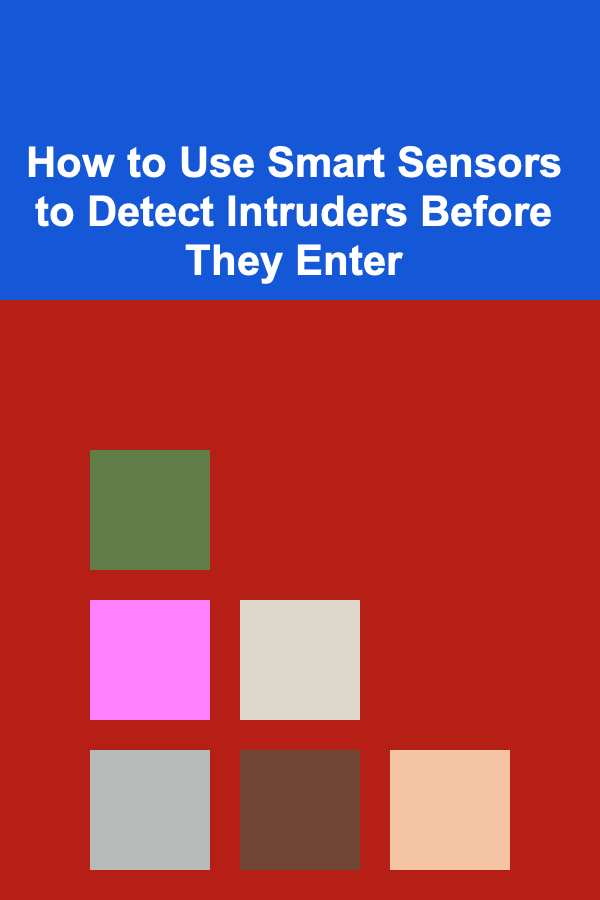
How to Use Smart Sensors to Detect Intruders Before They Enter
ebook include PDF & Audio bundle (Micro Guide)
$12.99$7.99
Limited Time Offer! Order within the next:

The evolution of home security has shifted from traditional locks and alarms to advanced technology systems that are more sophisticated and proactive. One of the most powerful tools in modern security systems is the use of smart sensors. These sensors can detect intruders before they even have a chance to enter your home, offering a significant layer of protection. In this article, we will delve deep into how smart sensors work, the various types available, and how you can use them to safeguard your home or business from intruders.
Understanding the Concept of Smart Sensors
Smart sensors are devices embedded with technology that allows them to monitor their environment, gather data, and send that information to other systems or users. They function through various detection methods such as motion, heat, sound, or light. When integrated into a smart home or business security system, these sensors provide real-time alerts and can activate other security devices (like cameras or alarms) upon detecting suspicious activity.
Types of Smart Sensors for Intruder Detection
To effectively detect intruders before they enter, different types of sensors can be strategically placed around the home or property. Below are the most common types of sensors used for this purpose:
1. Motion Sensors
Motion sensors are among the most common types of security sensors. They are designed to detect physical movement within their range. These sensors work by detecting changes in infrared radiation (heat) or by using ultrasonic waves to sense movement. When an intruder crosses the sensor's detection zone, it sends a signal to trigger an alarm or notify the homeowner.
How Motion Sensors Work
There are two main types of motion sensors:
- Passive Infrared (PIR) Sensors: These sensors detect infrared radiation, which is emitted by warm bodies, such as humans. PIR sensors are typically placed on walls or ceilings and cover a broad area. They are most effective in low-light environments, making them ideal for night-time detection.
- Microwave Sensors: These sensors emit microwave radiation and measure the return of the waves. A change in the frequency of the returning waves indicates movement. Microwave sensors are more sensitive and can detect movement through walls and doors, although they are often used in conjunction with other types of sensors.
Where to Place Motion Sensors
Motion sensors should be placed in strategic areas around the property, particularly in entry points such as doorways and windows. They should also be installed in larger spaces such as living rooms and hallways where movement is more likely to occur.
2. Door and Window Contact Sensors
Door and window sensors are designed to detect the opening or closing of a door or window. They are typically small magnetic sensors, which consist of two parts: a magnet and a sensor. When the door or window is closed, the magnet and sensor are aligned, creating a closed circuit. When the door or window is opened, the circuit is broken, and the sensor sends an alert.
How Door and Window Sensors Work
These sensors work by detecting changes in the magnetic field. When the door or window opens, it disrupts the magnetic field, causing the sensor to activate and send a signal to the security system. These sensors are highly effective at detecting an intruder's initial entry, providing an early warning before they can gain full access to the property.
Where to Place Door and Window Sensors
These sensors should be installed on all doors and windows that provide access to the home. Additionally, sensors can be installed on garage doors or gates to prevent unauthorized access to these entry points.
3. Glass Break Sensors
Glass break sensors are designed to detect the sound of breaking glass, which is often an indication of an intruder trying to force entry through a window or glass door. These sensors can differentiate between the sound of breaking glass and other ambient noises, providing accurate detection.
How Glass Break Sensors Work
Glass break sensors typically use microphones to listen for the distinct frequencies of glass shattering. Some sensors are tuned to detect specific sound patterns that are characteristic of breaking glass, such as the high-pitched sound of glass cracking. Other sensors use vibration detection, which can sense the impact of an object being used to break the glass.
Where to Place Glass Break Sensors
Glass break sensors should be placed near windows and glass doors, particularly in areas where it is most likely that an intruder would attempt to break through. These sensors are especially useful in homes with multiple windows or glass entrances.
4. Vibration Sensors
Vibration sensors are used to detect movements or vibrations on surfaces such as walls, floors, or windows. These sensors can detect an intruder attempting to break into a property by forcing or tampering with windows or doors. Vibration sensors are often used in combination with other types of security sensors for more accurate detection.
How Vibration Sensors Work
Vibration sensors operate by detecting changes in the vibrations of surfaces. If an intruder attempts to force open a door or window, or if there is an impact on a surface (such as kicking in a door), the sensor detects the vibrations and sends an alert. These sensors are often placed on windows, doors, and walls to monitor potential weak spots.
Where to Place Vibration Sensors
Vibration sensors should be placed on doors and windows that may be prone to tampering. They can also be placed on exterior walls or near other areas where an intruder may attempt to break in.
5. Environmental Sensors (Sound, Heat, and Pressure)
Some advanced smart security systems include sensors that monitor environmental factors such as sound, heat, or pressure changes. These sensors are useful in detecting intruders before they enter by identifying changes in the environment caused by human presence.
How Environmental Sensors Work
- Sound Sensors: These sensors listen for specific sounds, such as footsteps or the sound of someone climbing over a fence. They can detect sounds associated with intruders, even if the intruder is still outside the home.
- Heat Sensors: Heat sensors detect changes in temperature and can identify the body heat of an intruder. This makes them ideal for detecting people in low-light or dark environments.
- Pressure Sensors: These sensors are placed in the ground or on surfaces such as window ledges or doors. When pressure is applied to the surface, it sends an alert. These are commonly used to detect when someone is trying to break into a property.
Where to Place Environmental Sensors
These sensors can be placed at entry points, like doorways or windows, to detect changes when an intruder is nearby. Pressure sensors can also be used along fences or at the perimeter of your property to detect movement before someone approaches the house.
How to Integrate Smart Sensors into a Comprehensive Security System
Smart sensors can be even more effective when integrated into a comprehensive security system. Integration allows sensors to communicate with other devices, such as security cameras, alarms, and lights, creating a more robust security solution.
1. Connect to a Smart Hub
A smart hub is the central control unit that connects all smart devices in a home, including sensors, cameras, and alarms. By integrating your smart sensors with a smart hub, you can monitor and control them from a single platform. A smart hub allows you to receive real-time notifications on your phone or computer when any of the sensors are triggered.
2. Link Sensors with Security Cameras
Linking your smart sensors with security cameras provides added protection. For example, when a motion sensor detects movement, it can trigger the security cameras to begin recording. This provides valuable footage of the intruder, which can be used for identification or as evidence.
3. Use Smart Lights for Deterrence
Smart lights can also be integrated with your security system. When an intruder is detected by a motion sensor, smart lights can automatically turn on, illuminating the area and making it more difficult for the intruder to move around unnoticed. The sudden illumination can act as a deterrent, causing the intruder to flee.
4. Set Up Remote Alerts
One of the major benefits of smart sensors is that they can send alerts to your phone or email when triggered. You can set up remote alerts so that you are notified immediately when there is an intrusion attempt. These alerts can also be sent to monitoring services or local authorities if your system is professionally monitored.
5. Automate Security Responses
Smart sensors can be programmed to automate specific security responses when an intrusion is detected. For example, the system can trigger an alarm, lock doors, and notify the authorities all at once, providing a rapid response to the situation.
Conclusion
Using smart sensors to detect intruders before they enter your home is an effective and proactive way to enhance home security. By implementing motion sensors, door and window contact sensors, glass break sensors, vibration sensors, and environmental sensors, you can monitor your property for suspicious activity and take action before a break-in occurs.
The key to maximizing the effectiveness of smart sensors lies in their integration with other security measures, such as cameras, alarms, and smart lighting. By combining these devices into a cohesive system, you can create a powerful security network that will significantly reduce the risk of a break-in.
In an increasingly connected world, the future of home security lies in smart technology. By investing in smart sensors and integrating them into your home security system, you are taking a significant step toward protecting your home, your loved ones, and your peace of mind.
Reading More From Our Other Websites
- [Organization Tip 101] How to Keep Your Workspace Clutter-Free
- [Metal Stamping Tip 101] Best Eco‑Friendly Metal Stamping Practices for Reducing Waste in Small‑Batch Production
- [Home Family Activity 101] How to Create a Family Gratitude Journal Together
- [Organization Tip 101] How to Choose Between a Jigsaw and Circular Saw for Precision Cutting
- [Personal Finance Management 101] How to Plan for Healthcare Costs Without Overspending
- [Personal Investment 101] How to Build a Diversified Investment Portfolio
- [Home Party Planning 101] How to Host a Potluck Party at Home Like a Pro
- [Organization Tip 101] How to Organize Your Pet's Playtime Activities
- [Organization Tip 101] DIY Roof Shingle Replacement: Tools and Materials You'll Need
- [Paragliding Tip 101] What Pilots Need to Know About Maintaining and Renewing Their Paragliding Certifications

How to Stage Your Home for Modern, Trendy Buyers
Read More
How to Understand the Behavior of Seals and Sea Lions
Read More
How to Secure AI in Cloud Environments
Read More
How To Create Engaging Sensory Play Experiences
Read More
Building a Profitable Online Business: A Comprehensive Guide
Read More
Brewing Coffee with the Delter Press: A Comprehensive Guide
Read MoreOther Products

How to Stage Your Home for Modern, Trendy Buyers
Read More
How to Understand the Behavior of Seals and Sea Lions
Read More
How to Secure AI in Cloud Environments
Read More
How To Create Engaging Sensory Play Experiences
Read More
Building a Profitable Online Business: A Comprehensive Guide
Read More